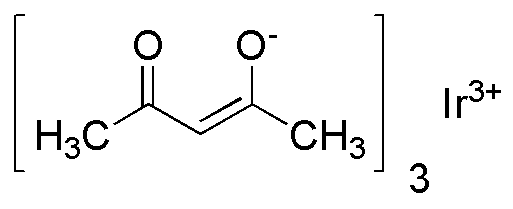Iridium(III) acetylacetonate is widely utilized in research focused on various applications:
- Catalysis: This compound serves as an effective catalyst in organic reactions, particularly in the synthesis of complex molecules, enhancing reaction rates and selectivity.
- Photovoltaics: It is used in the development of organic light-emitting diodes (OLEDs) and solar cells, improving energy conversion efficiency due to its excellent photophysical properties.
- Biomedical Applications: The compound shows promise in drug delivery systems and as a potential anti-cancer agent, leveraging its unique coordination chemistry for targeted therapies.
- Material Science: It is employed in the production of advanced materials, such as luminescent polymers, which are used in displays and lighting technologies.
- Analytical Chemistry: Iridium(III) acetylacetonate is utilized in analytical techniques, such as mass spectrometry, for the detection and quantification of various substances due to its stability and sensitivity.
General Information
Properties
Safety and Regulations
Applications
Iridium(III) acetylacetonate is widely utilized in research focused on various applications:
- Catalysis: This compound serves as an effective catalyst in organic reactions, particularly in the synthesis of complex molecules, enhancing reaction rates and selectivity.
- Photovoltaics: It is used in the development of organic light-emitting diodes (OLEDs) and solar cells, improving energy conversion efficiency due to its excellent photophysical properties.
- Biomedical Applications: The compound shows promise in drug delivery systems and as a potential anti-cancer agent, leveraging its unique coordination chemistry for targeted therapies.
- Material Science: It is employed in the production of advanced materials, such as luminescent polymers, which are used in displays and lighting technologies.
- Analytical Chemistry: Iridium(III) acetylacetonate is utilized in analytical techniques, such as mass spectrometry, for the detection and quantification of various substances due to its stability and sensitivity.
Documents
Safety Data Sheets (SDS)
The SDS provides comprehensive safety information on handling, storage, and disposal of the product.
Product Specification (PS)
The PS provides a comprehensive breakdown of the product’s properties, including chemical composition, physical state, purity, and storage requirements. It also details acceptable quality ranges and the product's intended applications.
Certificates of Analysis (COA)
Search for Certificates of Analysis (COA) by entering the products Lot Number. Lot and Batch Numbers can be found on a product’s label following the words ‘Lot’ or ‘Batch’.
Numéro de catalogue
Numéro de lot/série
Certificates Of Origin (COO)
This COO confirms the country where the product was manufactured, and also details the materials and components used in it and whether it is derived from natural, synthetic, or other specific sources. This certificate may be required for customs, trade, and regulatory compliance.
Numéro de catalogue
Numéro de lot/série
Safety Data Sheets (SDS)
The SDS provides comprehensive safety information on handling, storage, and disposal of the product.
DownloadProduct Specification (PS)
The PS provides a comprehensive breakdown of the product’s properties, including chemical composition, physical state, purity, and storage requirements. It also details acceptable quality ranges and the product's intended applications.
DownloadCertificates of Analysis (COA)
Search for Certificates of Analysis (COA) by entering the products Lot Number. Lot and Batch Numbers can be found on a product’s label following the words ‘Lot’ or ‘Batch’.
Numéro de catalogue
Numéro de lot/série
Certificates Of Origin (COO)
This COO confirms the country where the product was manufactured, and also details the materials and components used in it and whether it is derived from natural, synthetic, or other specific sources. This certificate may be required for customs, trade, and regulatory compliance.

